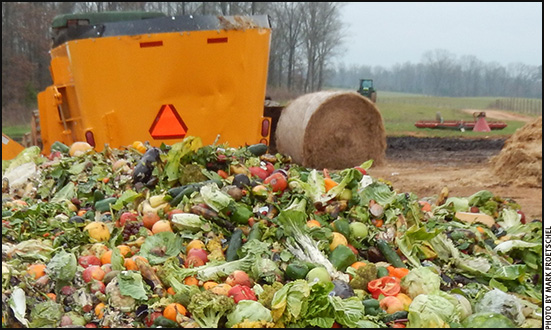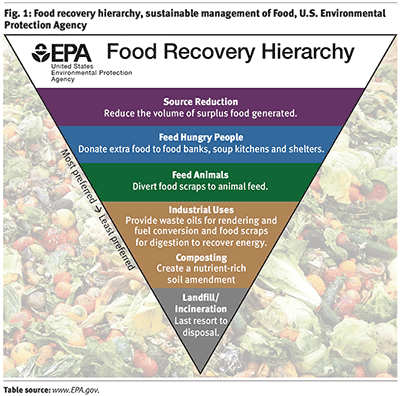
Leftover Grocery Produce
Makes Great Cattle Feed
Unwanted fruits and vegetables avoid the landfill and find a place on the feed menu.
“We hate waste,” says Wal-Mart Stores Inc., the world’s largest retailer and grocery store chain in its 2016 Global Responsibility Report. In 2009, the company set a goal toward a zero-waste future. By 2015, Wal-Mart U.S. was able to divert 82% of its materials away from landfills.
As a crucial piece in Wal-Mart’s sustainability puzzle, cattle have proven themselves once again. Leftover, damaged or undesirable fruit, vegetables and bakery items that can’t be donated to food banks are being delivered to feedbunks every day.
It’s people food
A retired professor from the University of Georgia (UGA), Mark Froetschel first studied the use of recovered retail food as feed for Holstein steers at UGA. He fed the product at zero, 20%, 40% and 60% of a total mixed ration (TMR). The study proved the food — originally intended for humans — to be highly nutritious [80% total digestible nutrients (TDN) on a dry-matter (DM) basis] and a cost-effective way to put gain on cattle.
Now a consulting nutritionist, he describes it as “people food in a semi-fresh state,” but more specifically as, “fruit and vegetable items from large retail grocery stores with some bakery items.”
As a partner in Collins Farms and consultant to Organix Recycling LLC, one of the country’s largest collectors of food residuals, Jim Collins says while he feels recycled food is a wholesome product for cattle, it is a good idea to work with your recycling service provider to determine your state’s policy regarding how it should be handled and fed.
From aisle to feed pile
After Wal-Mart announced its zero-food-waste initiative, recycling companies jumped onboard. Animal feed quickly became the best option behind donating the food before it expires to hungry people, says Froetschel.
“It’s one of the more promising ways to recover value from food waste that was going into the landfill,” he states.
Collins, a registered- and commercial-Angus producer and industry consultant based in Cusseta, Ala., says, “For producers who are using any kind of a total mixed ration or doing things where they have a need to feed cattle year-round, it has a lot of opportunities.”
Farm use
On average, the product is approximately 15% DM, though this can vary on a regional and seasonal basis.

As a fresh product, Froetschel recommends feeding it within two to three days. He says it works best when it is stored in a sloped concrete bin or pit, much like one would store wet brewers’ grains.
Kevin Yon, registered-Angus breeder and owner of Yon Family Farms in Ridge Spring, S.C., has been using recovered retail food for the past five years.
“We get about seven tractor-trailer loads per week. It’s delivered five to six days a week year-round,” says Yon.
While he likes the product thanks to its nutrition, cost and sustainability factors, he chooses to use it sparingly. Ideally, he would take it on a seasonal basis when he had the most need, “but this is a product that keeps right on coming,” he jokes.
Yon has gotten creative in finding uses for the seemingly endless supply of produce.
“With lots of cows we can blend it with something like wheat straw or cotton gin waste and make a nice ration for a dry cow pretty easy, or we can mix it with other products like corn silage, soy hulls, or dried distillers’ grains or corn gluten pellets and have a feed that will grow young livestock.”
Specifically, Yon uses the product for developing his 900 registered bulls and heifers.
Cattle reaction
While blending the byproduct helps bind some of the free water, in Froetschel’s, Collins’ and Yon’s experience, it does nothing to hide the high palatability of the fruits and vegetables.
Yon says his cattle go through a learning curve when first introduced, but once they figure out how to eat it, they love it.
“To our knowledge there’s no real sorting. They like it all. Basically, all they are leaving in the bunk would be a peach pit or an apricot shell,” says Yon.
Recycled food has a place on Yon’s farm as long as it continues to be cost-competitive with other feeds. However, maybe what he likes best about the product is the way it shows off the versatility of beef cattle.
“This is a product that was going to the landfill, and now, we can use cattle to turn it into something very tasty, which is beef,” Yon concludes.
For more information on recovered retail food as cattle feed refer to the October 2016 issue of the Angus Journal.

Editor’s Note: Paige Nelson is a freelance ag journalist and cattlewoman from Rigby, Idaho.






